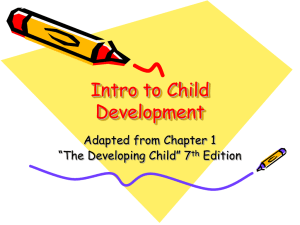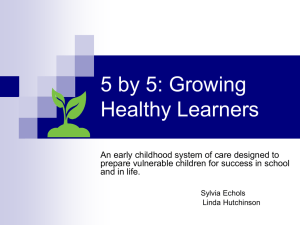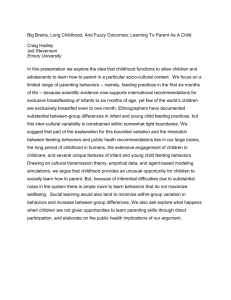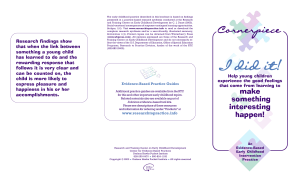Chapter 1 Outline - Eaton Community Schools
advertisement
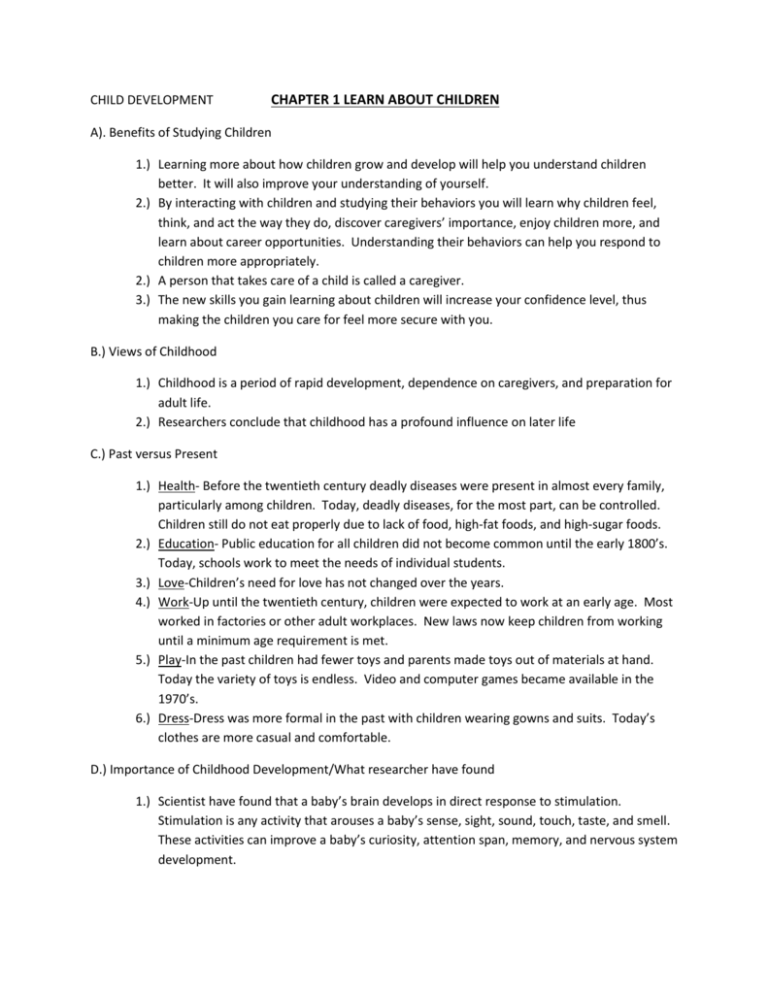
CHILD DEVELOPMENT CHAPTER 1 LEARN ABOUT CHILDREN A). Benefits of Studying Children 1.) Learning more about how children grow and develop will help you understand children better. It will also improve your understanding of yourself. 2.) By interacting with children and studying their behaviors you will learn why children feel, think, and act the way they do, discover caregivers’ importance, enjoy children more, and learn about career opportunities. Understanding their behaviors can help you respond to children more appropriately. 2.) A person that takes care of a child is called a caregiver. 3.) The new skills you gain learning about children will increase your confidence level, thus making the children you care for feel more secure with you. B.) Views of Childhood 1.) Childhood is a period of rapid development, dependence on caregivers, and preparation for adult life. 2.) Researchers conclude that childhood has a profound influence on later life C.) Past versus Present 1.) Health- Before the twentieth century deadly diseases were present in almost every family, particularly among children. Today, deadly diseases, for the most part, can be controlled. Children still do not eat properly due to lack of food, high-fat foods, and high-sugar foods. 2.) Education- Public education for all children did not become common until the early 1800’s. Today, schools work to meet the needs of individual students. 3.) Love-Children’s need for love has not changed over the years. 4.) Work-Up until the twentieth century, children were expected to work at an early age. Most worked in factories or other adult workplaces. New laws now keep children from working until a minimum age requirement is met. 5.) Play-In the past children had fewer toys and parents made toys out of materials at hand. Today the variety of toys is endless. Video and computer games became available in the 1970’s. 6.) Dress-Dress was more formal in the past with children wearing gowns and suits. Today’s clothes are more casual and comfortable. D.) Importance of Childhood Development/What researcher have found 1.) Scientist have found that a baby’s brain develops in direct response to stimulation. Stimulation is any activity that arouses a baby’s sense, sight, sound, touch, taste, and smell. These activities can improve a baby’s curiosity, attention span, memory, and nervous system development. 2.) Development is similar for each individual- all infants follow a predictable sequence of development at about the same ages. 3.) Development builds upon earlier learning. 4.) Development proceeds at an individual rate, usually due to factors such as heredity and their environment that influence their development. Heredity includes blood type, eye color, hair color, etc. Heredity is often referred to as nature. Environment is the people, places and things that surround and influence a person including family, home, school and community. 5.) The different areas of development are interrelated. 6.) Development is continuous throughout life. 7.) Self Esteem- also known as self-worth. Children who feel good about themselves are more likely to show enthusiasm for learning, form friendships and make healthy choices. E.) Theorists 1.) Sigmund Freud-Believed that personality develops in stages and experiences in childhood affect adult life. 2.) Jean Piaget- The first to study children scientifically. 3.) Lev Vygotsky-Believed that social contact is essential to intellectual development. 4.) Erik Erikson-Believed that personality develops in stages and that each stage includes a unique psychological crisis that must be met in a positive way to develop normally. 5.) B.F. Skinner-Argued that when a child’s actions have positive results, they will be repeated. Negative results will make the actions stop. 6.) Urie Bronfenbrenner-Outlined layers of environment that affect a child’s development, such as the child’s own biology, family/community environment, and society. 7.) Albert Bandura-Disagreed with Skinner. Believed that children learn by imitating others and pointed out that the environment shapes behavior and behavior also affects the environment. F.) Stages of Life After Childhood 1.) Adolescence-The stage of life between childhood and adulthood where people create an identity, become independent and pursue education and careers. 2.) Young adulthood-People in their twenties (starting a job, getting married). 3.) The Thirties-Stage were people establish their roots, reevaluate life choices made earlier, find stability in a career and relationships. 4.) Middle Age-The stage from about ages 40-55 (children become more independent, some people start a new career). 5.) Late Adulthood-Usually ages 55-75. Many adults retire, travel, take classes, or enjoy hobbies. Some even take on a part-time job. Health issues may arise at this stage. 6.) Very Late Adulthood-Beyond age 75. Health problems are more common and they may need more assistance or care. Some people still remain active and contribute their knowledge and experience to society. G.) Why We Observe Children 1.) We can learn a great deal from reading about children; however, observing them is even more helpful. 2.) Knowing how to record what you observe and analyze it later will give you insight into children’s development-you must have a written record of your observation to refer to for analysis. H.) Types of Observations 1.) Subjective-Relying on personal opinions and feelings, rather than facts, to judge an event. 2.) Objective-Something that is factual, and leaves aside personal feelings and prejudices. I.)Types of Observation Records 1.) Running Record-A record of everything observed for a set period of time (ex. 15 minutes) 2.) Anecdotal Record-A report of a child’s actions that concentrates on a specific behavior or area of development. 3.) Frequency Count-Tally of how often a certain behavior occurs (useful when trying to change an unwanted behavior). A baseline (count made before any steps are taken to try to change the behavior) is taken, attempts to change the behavior are made, and additional frequency counts are made. 4.) Developmental Checklist-A list of skills children should master, or behaviors they should exhibit at a certain age. Consists of simply checking off the skills or behaviors they see. J.) How To Act While Observing 1.) Informal Observation-you do not make yourself obvious, you do not know the ages of the children. 2.) Formal Observation-You set up a time and place to observe a child. 3.) Avoid calling attention to yourself. 4.) Understand your observation assignment. 5.) Be prepared. 6.) Be respectful of others. 7.) Answer questions honestly and be brief. 8.) Avoid asking questions. K.) How To Interpret Observations 1.) You might want to transfer our notes to another sheet of paper or type them because some notes are kept in a student’s file. 2.) Next, interpret the information. Interpretation-the analysis the observer forms and expresses about what was observed. 3.) Confidentiality-protection of another person’s privacy by limiting access to personal information.




